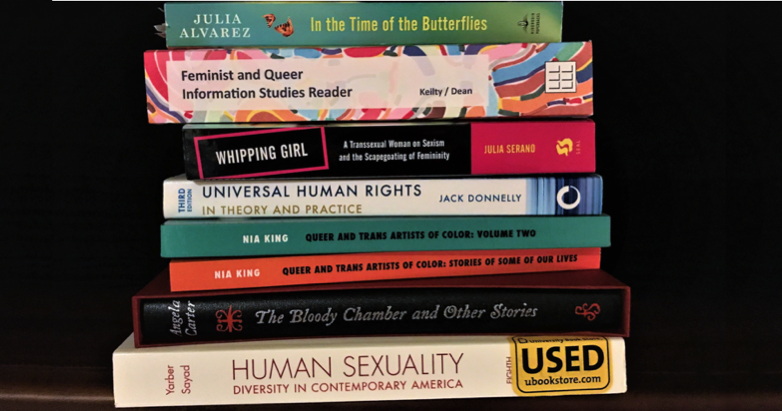Hello, beautiful creatures!
So, this is the point where I advise you to buckle up, because we’re going hard for the next little bit. In case you’ve missed it the previous seventeen times I’ve mentioned it, I have a gender studies degree, and by gods, I’m going to make use of it here. I’m not trying to justify the expense of a squishy interdisciplinary degree (well, not entirely, anyway), but rather, to talk about an ongoing issue in the interlocking subcultures of practice and play I’ve taken to calling “the P-word community.” (All credit for this term goes to the delightful Laura Tempest Zakroff, who coined it here.)
The issue, in case you missed the title of this piece, is the problem of gender essentialism.
Defining Gender Essentialism, and Why It’s a Problem
At the risk of making one of the classic blog-writing blunders, right up there with going against a Sicilian when death is on the line, I’m going to start this post off by laying out a quick-and-dirty definition of “gender essentialism.” Since it’s a composite term, I want to approach it in two steps:
- Essentialism is the belief or position that any given thing has a fixed, innate “essence,” a set of qualities which make it itself, and not something else. For example, in the category of “fruits,” oranges are oranges, rather than apples, because they have the essential nature of “orange”: a set of qualities which, taken as a whole, we assign to the descriptor “orange,” rather than to “apple.”
- Gender essentialism is the belief that (a.) there is some innate essence to the genders we designate “woman” and “man,” (b.) these essential qualities are identical for all members of these genders, and (c.) these genders are biologically determined.
There’s a lot more to it, of course. This is just the quick version. (For some of that “a lot more,” allow me to direct you to Judith Butler’s Gender Trouble: Feminism and the Subversion of Identity, Elizabeth Grosz’s Space, Time, and Perversion: Essays on the Politics of Bodies, and Simone de Beauvoir’s classic The Second Sex.)
One of the big problems with gender essentialism is that, because of its claim to universality, it’s used to justify a lot of oppressive, dehumanizing, abusive, and just plain awful ideas about people. In order to buy into a gender-essentialist view, you have to believe that there is some inherent non-biological quality—which is somehow still biologically-determined, mind you—which intrinsically separates everybody into one of two categories, and that this essence is universal to all cultures throughout history. Predictably, this dismisses the lived experiences of people—women, men, and others—who don’t fit neatly into those categories, or whose experiences don’t align with the ostensibly universal experience of gender attributed to persons belonging to a given category. Nevertheless, it’s a view shared by a number of folks with an investment in advancing regressive sociopolitical agendas around gender, including trans-exclusionary radical feminists1 and right-wing Christians.
What does this have to do with Paganism, polytheism, magic, and the like? I’m getting there, I promise. First, though, I want to talk about something I saw on social media.
A Thematically Necessary Detour
In the wake of the flood resulting from Hurricane Harvey’s landfall in Texas, social media was filled with images and commentary about the events. Some of those images were of the disaster itself and the chaos it caused, while others captured the human responses to that chaos and disaster. (NB: If you’d like to send aid to the people affected by the devastation of Hurricane Harvey, the New York Times has a decent list of resources you can support. Additionally, ColorLines has published a list of organizations specifically serving the needs of people of color and other marginalized communities often missed or ignored by other aid organizations.)
One image in particular caught my eye, not merely because it was a moving image of someone giving aid to others, but because it was accompanied by a bolus of text from Matt Walsh, a Catholic pundit who bills himself as “a writer, speaker, and one of the religious Right’s most influential young voices.”
Woman cradles and protects child. Man carries and protects both. This is how it ought to be, despite what your gender studies professor says pic.twitter.com/oX85v67FaY
— Matt Walsh (@MattWalshBlog) August 28, 2017
“Woman cradles and protects child. Man carries and protects both. This is how it ought to be, despite what your gender studies professor says.”
Yes, well. Given that Walsh identifies as a Catholic, and that he just published a book about “blocking the Left’s assault on life, marriage, and gender,” I’m going to go out on a limb and suggest that he and I don’t really see eye-to-eye on the subject of gender. Nonetheless, his commentary does provide us with a perfect snapshot of the strongly-typed gender roles favored by conservatives in the U.S.: “This is how women are supposed to be, that is how men are supposed to be, and anything else is just liberal eggheads mucking about with God’s plan.”
It is, in other words, a textbook example of gender essentialism.

Getting to the Point
Despite Walsh’s dig at my field of study, I don’t actually have any particular desire to bash on the simplistic view of gender encapsulated in his tweet, on which he dilates at greater length on his Facebook page. I sincerely doubt he’d be able to hear anything I had to say, anyway, and I’m already wearyingly familiar with his line of reasoning2. I’d be dismissed from the outset anyway. First of all, I have a degree in gender studies, which apparently makes me a cultural Marxist or something3. Second, I’m nonbinary, a gender identity which folks like Walsh believe is just made-up anyway, along with heteronormativity, male privilege, toxic masculinity, and probably global climate change. So, we won’t go there. (Besides, Twitter has already dragged Walsh pretty hard for his fumble-fingered politicizing of the image, and an actual gender studies professor took the time to thoroughly dress him down for his gender-based nonsense.)
I do hope Walsh grows out of his unsophisticated bully-boy approach to gender issues. (He is, after all, a “young voice.”) Rather than mocking him any further, though, I want to point out that the views he presents aren’t all that different from views promulgated within the Pagan, polytheist, magical, and occult communities. And by “not all that different,” I mean they’re the same.
I’ll say that again, for the folks in the back: The views on gender held by a hard-right Christian blogger are virtually identical to the views on gender held by a lot of people in our communities.
“Wait, what?” I hear some of you protest. “Surely you misspoke… er, mistyped! We’re not anything like that! He’s a Catholic Christian! He’s oppressive and awful! That’s their thing! How can you say that about our beautiful P-word community?”
We’ll get to that soon… next week, in fact. In the meantime, stay safe out there, kids. ♥
To be continued…
___
- I realize “trans-exclusionary radical feminist” (abbreviated “TERF”) is a contentious term, and that some people believe it to be a slur. I maintain that it’s objectively descriptive. If radical feminists who want to exclude transgender women believe that a denotative description of their position is offensive, I don’t really know what to say to that, other than to agree that it’s offensive, and they should change their beliefs immediately.
- People under the transgender umbrella tend to know a hell of a lot more about gender and gender theory, both theoretically and experientially, than folks whose final recourse is to fall back on handwavy pseudoscience and “God said it, I believe it, that settles it.” It’s a survival skill.
- Seriously, what is with these people’s obsession with Marx and gender studies? I got through my degree program and never once had to read The Communist Manifesto! Did I sleep through a class or something?
















